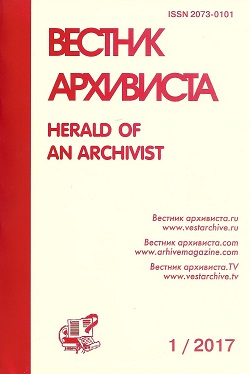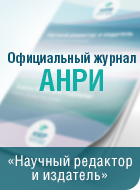Mobilized Laborers from Central Asia in the Urals in the Days of the Great Patriotic War of 1941–45: Characterizing Archival Sources and Rethinking the Points of View



Scientific article
УДК 93/94+930.8517.023.36+930.23+930.253+930.255+304.444+316.42+304.9+314.72+314.93+355.01+331.104.22+331.108+331.109.4+338.23+338.28+343.254+392.77+392.8+392.91+613.4+646.7+314.045
doi 10.28995/2073-0101-2023-4-1056-1066
Avdashkin, Andrey A.
South Ural State University, Chelyabinsk, Russian Federation
Mobilized Laborers from Central Asia in the Urals in the Days of the Great Patriotic War of 1941–45: Characterizing Archival Sources and Rethinking the Points of View
Abstract
The article describes archival documents on the issue of lifestyle of the mobilized laborers’ from the Central Asian military district in the Urals in the days of the Great Patriotic War, which were deposited in the fonds of central and regional archives. The author examines cognitive potential and possible limitations of using these materials to study mass waves of Central Asian migration in the Soviet era from new angles of ethnicity, social organization of mobilized laborers, etc. He addresses such subjects as relations between mobilized laborers, peculiarities of their social organization, their behavior patterns under critical conditions, difficulties of medical support due to cultural and language barriers, etc. The source base is materials from the Russian State Archive of Socio-Political History (RGASPI), in particular, from the fond of the State Defense Committee (fond 644). A considerable layer of useful data is contained in the Chelyabinsk State Archive of the Chelyabinsk Region (OGACHO), in the fonds of the Magnitogorsk City Committee (fond P-234), the Chelyabinsk Regional Committee (fond P-288), the Party Committee of the Chelyabinsk Tractor Plant (fond P-124), and the Health Committee (fond R-1595). There is not enough space to describe all archival fonds containing valuable information, attention is focused only on major documents collections. Although most studied documents describe the considered phenomenon in quantitative terms, opportunities have been found for shifting research optics to anthropological subjects. Thoughtful work with new historiography on the topic of socialist construction in Central Asia in the 1920s–30s and practices of managing ethno-cultural diversity in the Soviet Union in the 1920s–40s allows the author to interpret known sources from a new angle, incorporating them into broader contexts. It is necessary to expand the source base, to attract new archival documents, materials from periodicals, and memoirs. On this basis, various waves of migration can be incorporated into a wider pattern of movements that connected the Urals and the Asian regions in the 20th–21st centuries. Such formulation of research questions seems productive and relevant in the context of growing need for historical reconstruction of labor migration from Central Asia.
Keywords
Historical sources, labor migration, Central Asian migration, mobilized laborers, Uzbeks, Urals, archival documents.
Download the article: avdashkin_doi
References
ALAMGIR, A. Labor and labor migration in state socialism. IN: Labor History, 2018, no. 3 (59), pp. 271-276
AMANZHOLOVA, D.A., KRASOVITSKAYA, T.Yu. The Cultural Complexity of Soviet Russia: Ideology and Management Practices 1917-1941. Moscow, Novyi khronograf publ., 2020, 384 р.
BAKHOVADINOVA, M. The ‘mobile proletariat’: the production of proletariat labor on a Soviet construction site. IN: Labor History, 2018, no. 3 (59), pp. 277-294.
KHALID, A. Creation of Uzbekistan. Nation, empire and revolution in the early Soviet period. In Russ.]. St. Petersburg, Academic Studies Press, 2022, 623 р.
ROBERTS, F. A time for feasting? Autarky in the Tajik Ferghana Valley at war, 1941–45. IN: Central Asian Survey, 2017, iss.1 (36), pp. 37-54.
SHMYROV, B. D. Mobilized laborers of the Central Asian military district in the southern Urals in 1942–45. Chelyabinsk, Tsitsero publ., 2018, 206 р.
TROFIMOV, A. V. Economy of the Urals during the Great Patriotic War in the contemporary historiography. IN: Ural'skii istoricheskii vestnik, 2020, no. 2 (67), pp. 116-125.
VESELKOVA, N. V. (Im)mobility in the mood of the Soviet people: Evacuees and labor mobilized in the Urals in the 1940s. IN: Sotsiologicheskii zhurnal, 2017, no. 2, pр. 115-135.
ZHARKYNBAYEVA, R. Labor Mobilization of Population from Central Asia during World War II: Conscription, Dislocation, and Conditions of Life and Work (on Examples from the Kazakh SSR). IN: The Journal of Slavic Military Studies, 2021, no. 4 (34), pp. 558-579.
About the authors
Avdashkin Andrey Alexandrovich, PhD in History, South Ural State University, senior researcher, Chelyabinsk, Russian Federation, +7-951-123-37-93, This e-mail address is being protected from spambots. You need JavaScript enabled to view it
Submitted 21.02.2023, published (for citation):
AVDASHKIN, A. A. Trudmobilizovannye iz Srednei Azii na Urale v gody Velikoi Otechestvennoi voiny 1941-1945 gg.: kharakteristika arkhivnykh istochnikov i popytka pereosmysleniya rakursov [Mobilized Laborers from Central Asia in the Urals in the Days of the Great Patriotic War of 1941–45: Characterizing Archival Sources and Rethinking the Points of View. In Russ.]. IN: Vestnik arhivista / Herald of an Archivist, 2023, no. 4, pp. 1056-1066. doi 10.28995/2073-0101-2023-4-1056-1066











